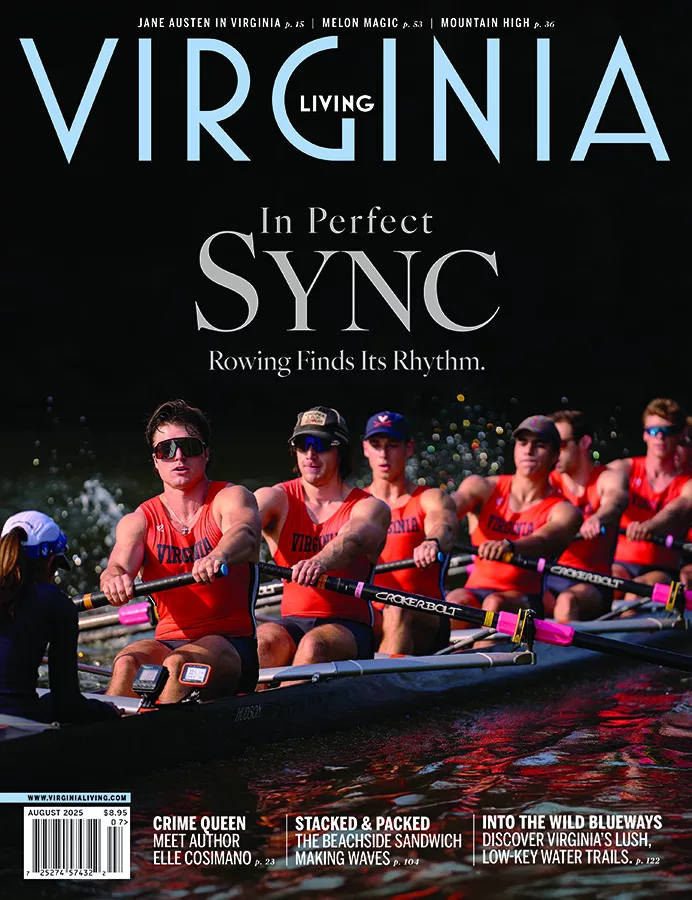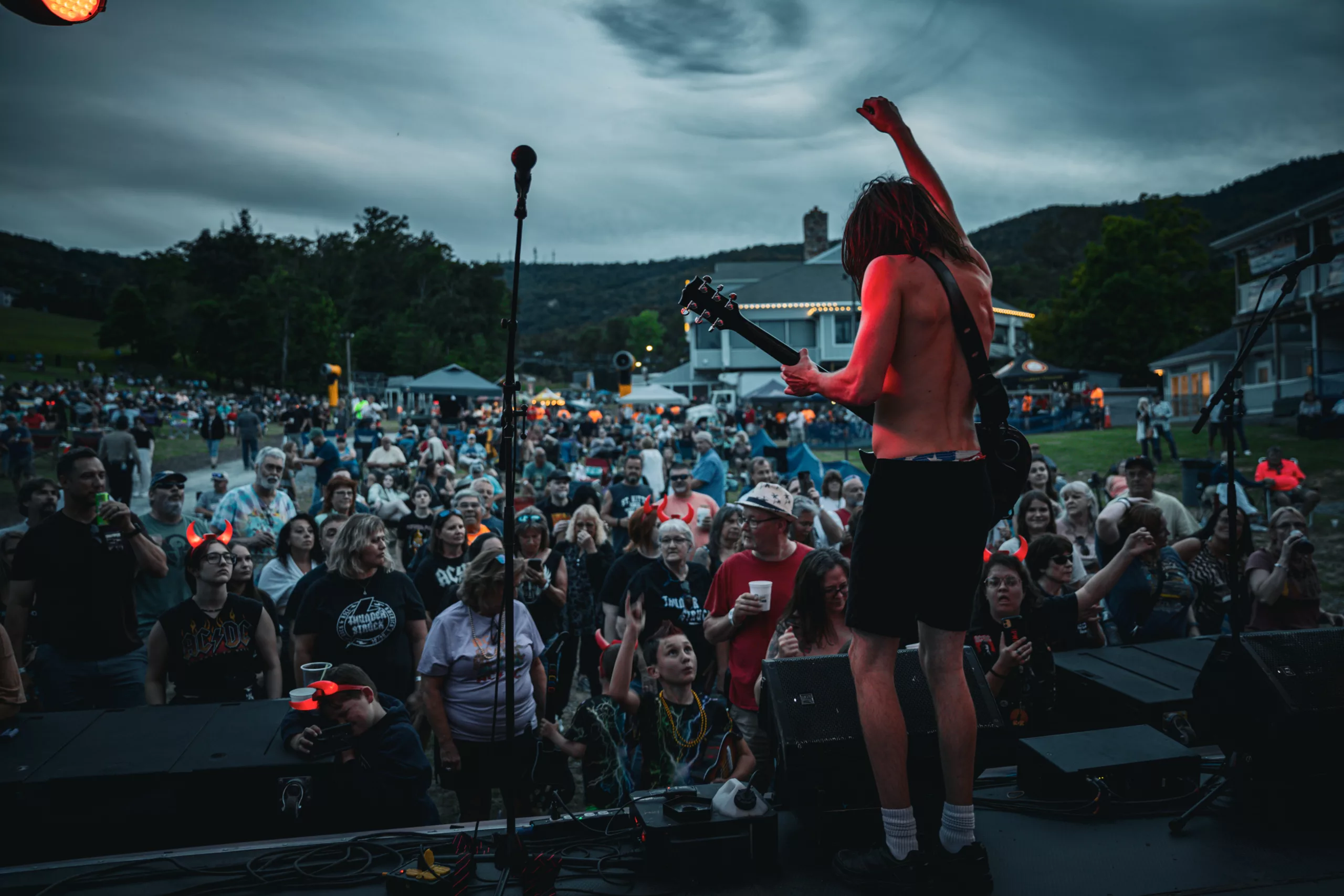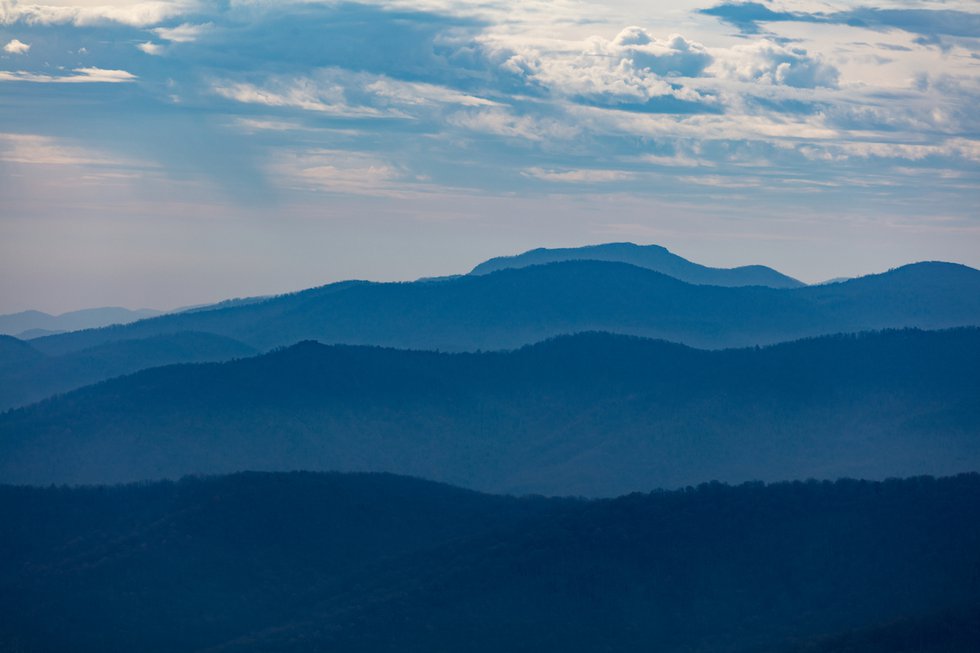On a chilly January morning, Jacob Roberts steps into the woods off a country road outside Harrisonburg and begins hitting brush with a long stick.
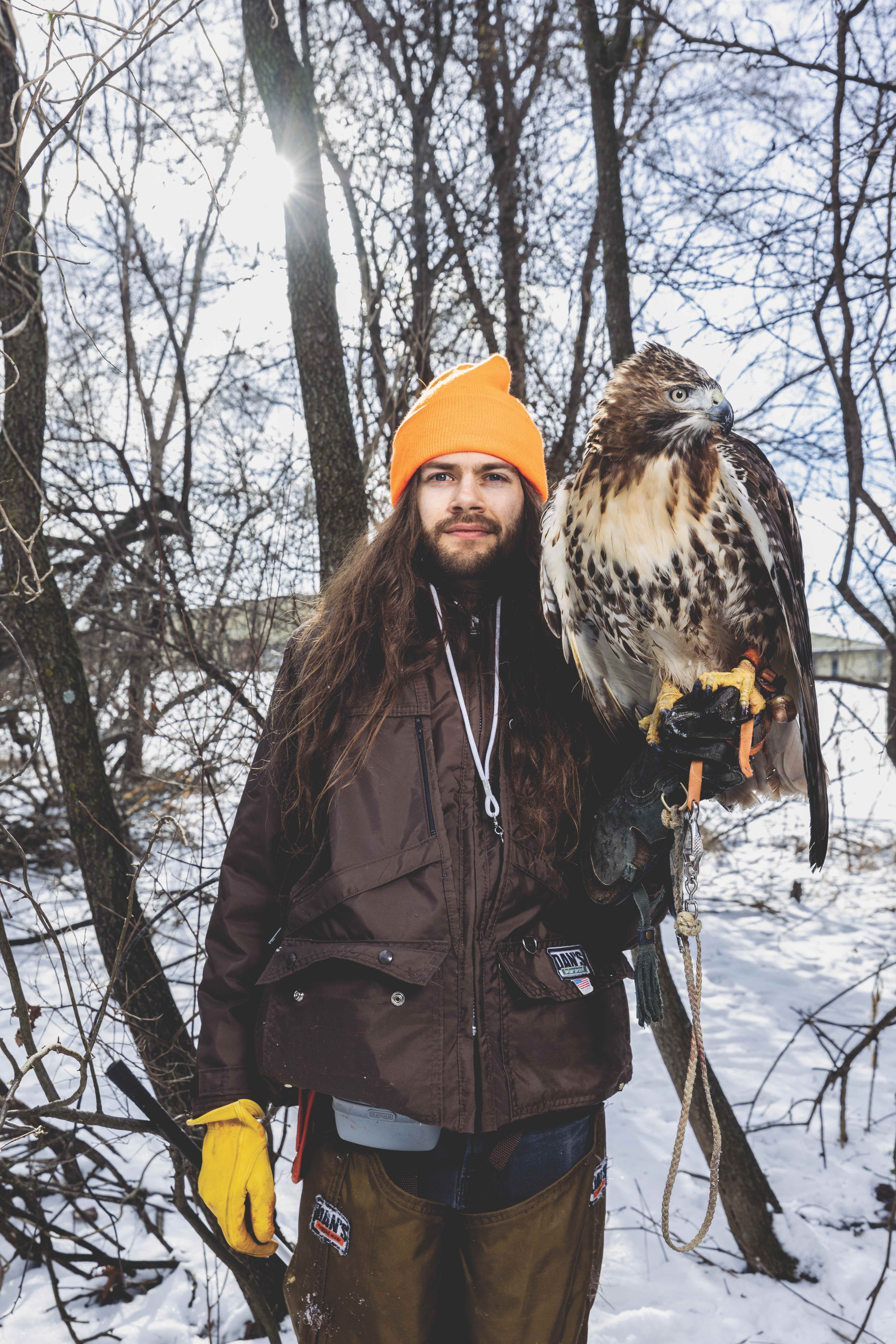
“Ho, ho, ho,” he yells, and a moment later he gets a response. A squirrel jumps from the growth and darts into the snow-covered forest. Athena, Roberts’ red-tailed hawk perched in a tree above him, dives toward the gray streak.
For the next few minutes, the action progresses deep into the woods. The raptor misses its mark, and the squirrel races up a towering tree. But when it jumps to a higher branch, the bird strikes again. Trigger warning here for the faint of heart: There’s a flurry of feathers and fur as they both tumble to the ground.
Roberts rushes over and pulls off his bird, trading him a piece of meat for the now-dead squirrel, which he places in a bag to feed Athena later. It feels like I’ve watched a nature documentary play out in front of me.
Jasmine Peak, who drove from Hampton to learn about falconry, is equally wowed. “You get a connection to nature like I’ve never had.”
This morning’s hunt, part of the annual winter meeting of the Virginia Falconers’ Association (VFA), has convinced Peak and her husband that they want to start the multiyear process to be certified to train and own a raptor.
Earlier that morning, I had joined the scruffy group of falconers and visitors in the lobby of the meet’s host hotel, the Harrisonburg Ramada Inn.
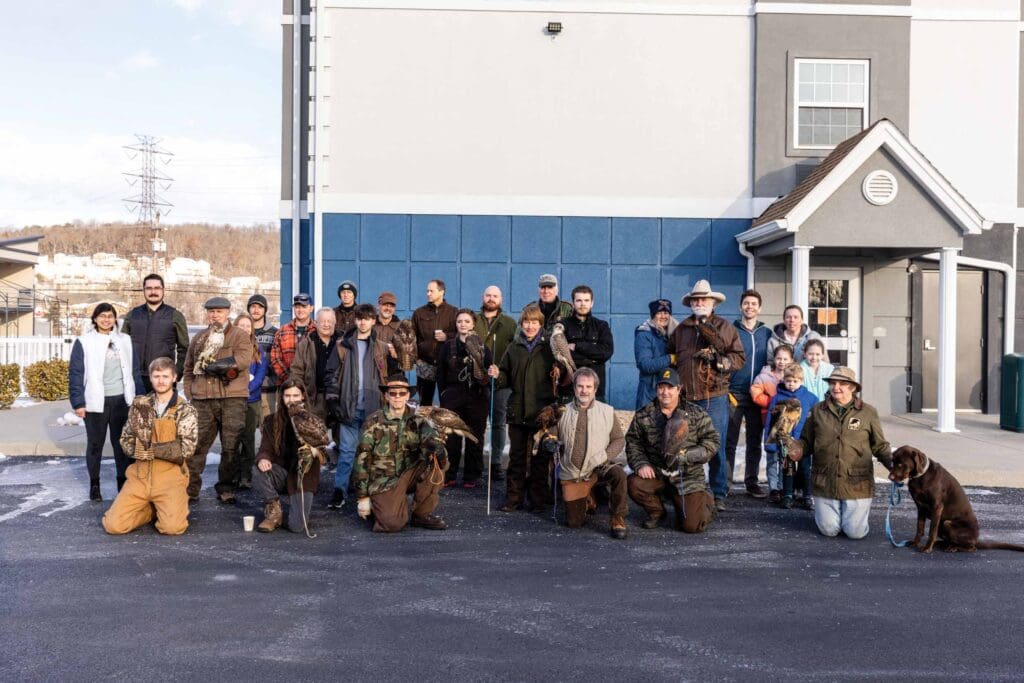
It felt like I’d wandered into a bizarre coffee shop, with some patrons holding cups and others with raptors perched on their arms. Most of the birds are docile, but occasionally one flutters in midair, trying to fly until it reaches the end of a short tether.
I was in select company. Falconry is strictly regulated with about 4,000 people in the nation licensed to own birds, and about 120 in Virginia, counting owners and apprentices. It takes at least two years to get credentialed, a lengthy process requiring a sponsor. Every bird caught and raised by a falconer is registered with the state and federal wildlife authorities, and owners must report when a bird is released, escapes, or dies.
The falconry season runs roughly from November through March. Many start by trapping a bird in the fall, first teaching it to eat from a gloved hand. Eventually, it will hunt with a human, working together to track down prey.
But come spring, falconers often release their bird to the wild in what can be an emotional moment—for the human.
“There’s a lot of poetry and magic,” says Eden Elmore, an electrical designer from Richmond, who has come out for the meet. “It’s the most connected relationship you can have with an animal.”
However, there’s one thing a falconer can’t forget, she tells me. “The bird doesn’t love you. You have to remember that. But you absolutely fall in love with your bird.”
No Cuddly Plaything
Falconers know that their raptor is no cuddly plaything. It’s a perfectly engineered killing machine, spying prey from the air and attacking often before the victim even knows it’s at risk.
It’s something Charlottesville-based nature writer Jennifer Ackerman learned several years ago. The New York Times best-selling author recalls how a falconer had her and a couple dozen others lie on their backs in a grassy field with their eyes shut. Without telling them what to expect, his assistant released a Harris’s hawk to swoop over their bodies.
“It was the most incredible experience,” she says. “You heard the swoosh. You can feel the breeze. You could hear the noise. It was the experience of being prey, honestly. You never see what’s coming.”
The Harrisonburg meet also attracts people like David Culotta, 71, of Richmond. He traces his interest in thesport to a childhood viewing of a 1958 Kirk Douglas movie, The Vikings. But it remained in the back of his mind until about eight years ago when he attended a VFA meeting and felt the pull of the sport.
“You have a wild bird, and first it doesn’t want anything to do with you,” he says. But with work the dynamic changes. “You can blow a whistle and call their name, and they’ll fly to your hand. It’s exciting and thrilling.”

First, Get a Bird
But first, you must get a bird. While they can be purchased, many falconers catch their own. Late last November, Culotta got a call from Roberts, the falconer whom I had seen nab a squirrel in Harrisonburg.
He knew Culotta was looking for a raptor and told him he had seen a few hawks in Midlothian. Working together, they laid out a trap behind a Target store that was baited with two live gerbils protected by a cage. Within minutes they had captured Odin, quickly attaching anklets with bells and hooding his eyes. Culotta then took him home to a spacious aviary called a mews that he had built in his backyard in Richmond’s Northside.
It was Culotta’s second hawk, and he knew he had to be tough, offering the bird food only when it jumped to his gloved hand. Within days the bird was responding, and over the next few weeks, Culotta began to blow a whistle and call Odin’s name when he offered him food. Training progressed to flying across the mews when leashed. Soon Culotta felt confident enough to let the bird fly untethered.
Returning is Roulette
But a falconer always wonders if the bird will return. Culotta remembers flying Odin in Caroline County. “All of sudden he took off.” For 45 minutes there was no sign of the bird. “I figured this is the end. This is the way it was supposed to be,” Culotta remembers.
He blew the whistle one last time. “I could barely faintly hear these bells going, and I thought Oh my gosh, he’s coming back. I can’t believe it.”
Some falconers keep birds for several years, but Culotta let Odin go. On March 25, the falconer’s birth- day, he removed the bird’s anklets and took him to a field in Hanover County.
“I kind of felt like I was doing the bird a big favor,” says Culotta. “This is where he’s supposed to be anyway. Being a falconer, you’re lucky you can borrow the bird and be with it for a while.”
Odin left Culotta’s arm and flew to a tree branch. “I stood around for 10 or 15 minutes, but he never really flew away. It was a pretty morning and eventually I thought: Okay, this is it. And I had to turn around and drive away.”
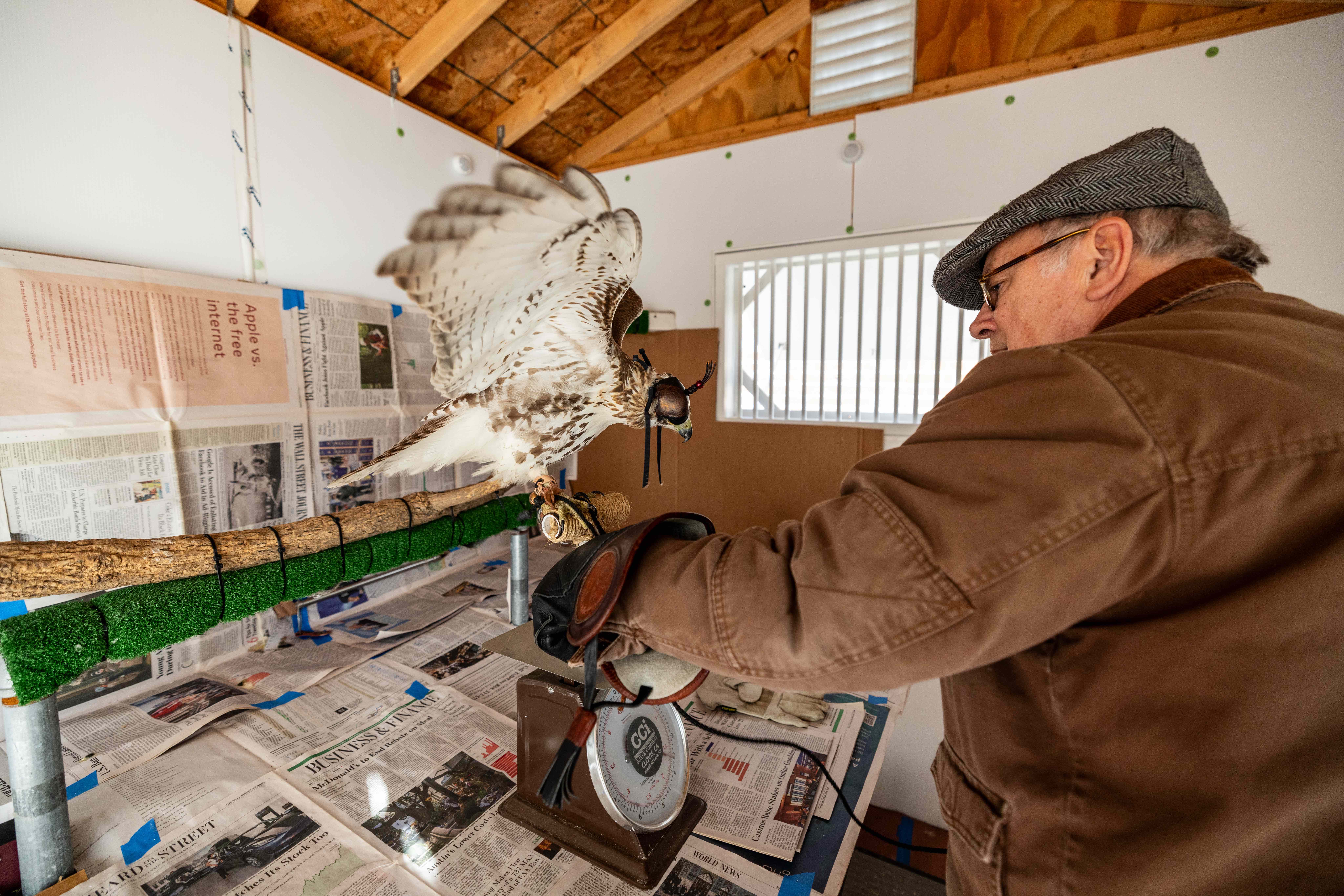
Raptor Speak
Back at the Ramada Inn, Brian Cullen, the president of the state falconry association, began to assemble members and their birds in the parking lot for a photo. The group made a curious collection, like a Game of Thrones fan club meeting with regal birds posed on leather gloves.
The most common Virginia raptors used by falconers are hawks, both red-tailed and Harris’s, and several are on display this morning with names like Tziporah, Pumpkin, and Cleopatra. There’s also a hybrid gyrsaker falcon named Polly, along with an aplomado falcon and a Eurasian goshawk.
Raptors face a high mortality rate in the wild. They’re often hit by cars as they eat roadkill or die after consuming a poisoned rodent. Captive birds have much better odds at survival, falconers say. “I doubt there are many raptors in the world that someone has not attempted to train and hunt with,” Cullen says, citing native North American birds including American kestrels (the smallest raptor), along with prairie falcons, peregrine falcons, merlin falcons, gyrfalcons, American goshawks, and golden eagles, one of the continent’s largest raptors.
In addition, some falconers use old-world species like Eurasian goshawks, Bonelli’s eagles, and several types of falcons, including lanner, merlin, and laggar.
Eventually, our group—raptors and falconers alike— pauses for a picture. Then everyone piles into cars to fan out to privately owned properties around Harrisonburg where the birds will soar.
A Wild Connection
Drake Haydock of Charlottesville traces his falconry interest to YouTube videos he began watching at age 12. Two years later, he was an apprentice. Now 24, he is raising and training Tonto, a regal red-tailed hawk he caught in a Sheetz parking lot on New Year’s Eve.
I met the pair at the Harrisonburg meet, and Haydock invited me to watch him train his bird. A few weeks later, we got together in an open field near Charlottes- ville where the day’s lesson was to fly from Haydock’s gloved hand to my gloved hand while attached to a long leash. It’s a crucial skill before free-flight.
When Haydock lifts his arm, Tonto pumps his wings to stabilize himself. I stand about 15 yards away, extend my arm and call out a command: Up!
Tonto rotates his head, his pinpoint eyes focusing on me. His wings pump again, and he zips across the gap separating us, pouncing on the leather glove covering my forearm. He tears a piece of meat from my hand, and turns to me, wanting more.
It feels like a dance—and a threat. And for a moment, I sense the same emotion I had felt on that cold morning hunt in Harrisonburg: a direct connection with the wild.
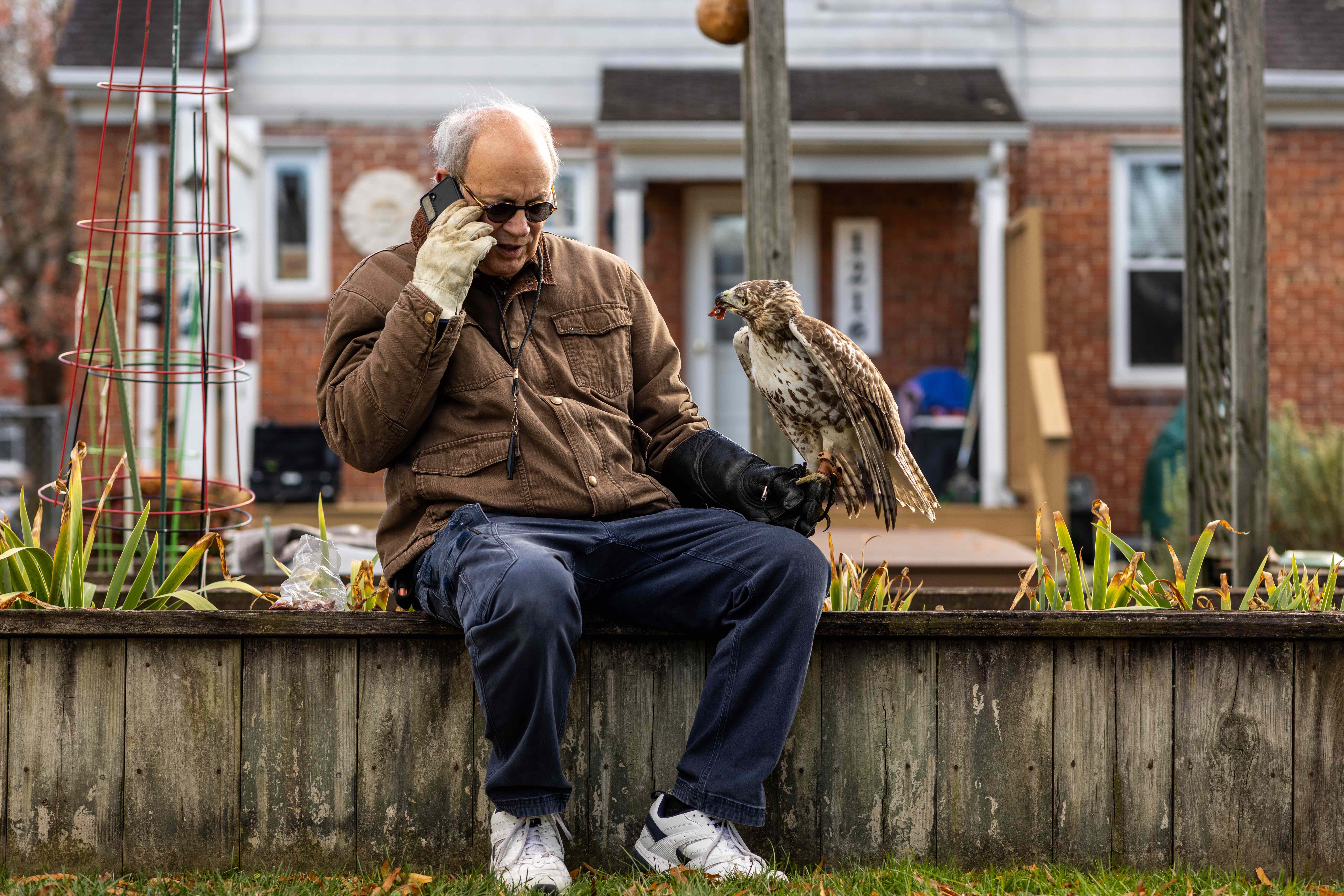
This article originally appeared in the October 2024 issue.
